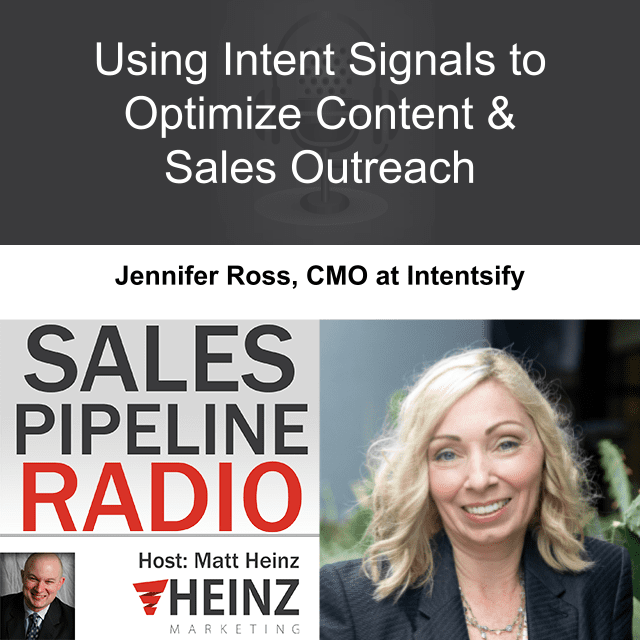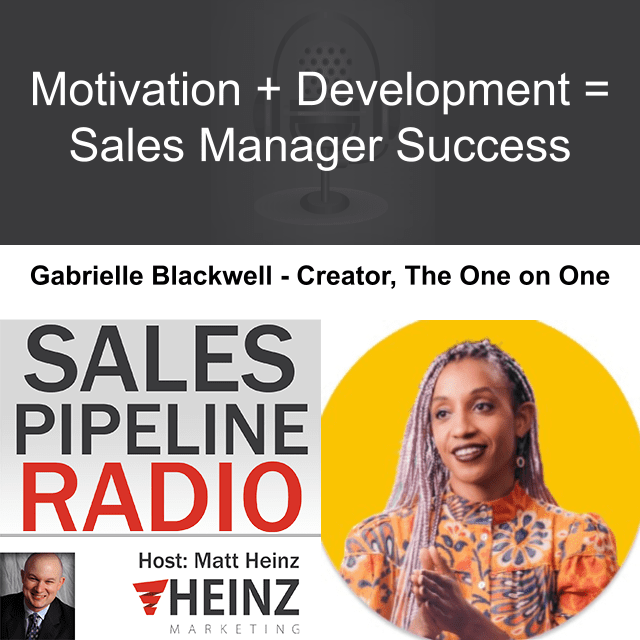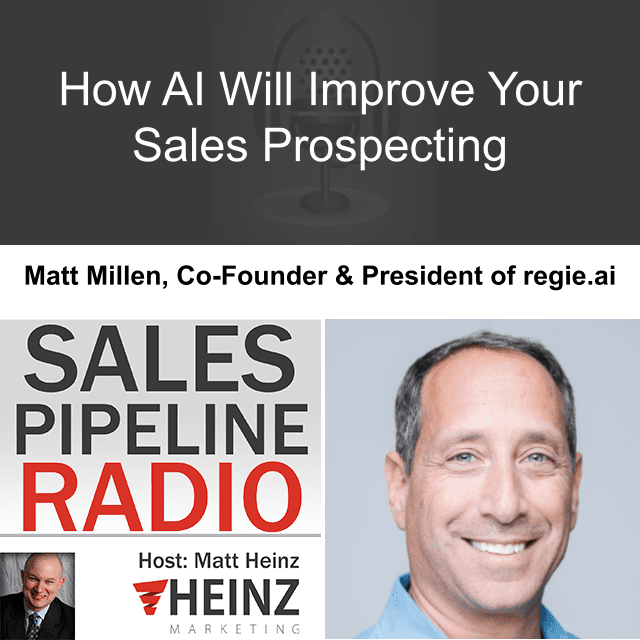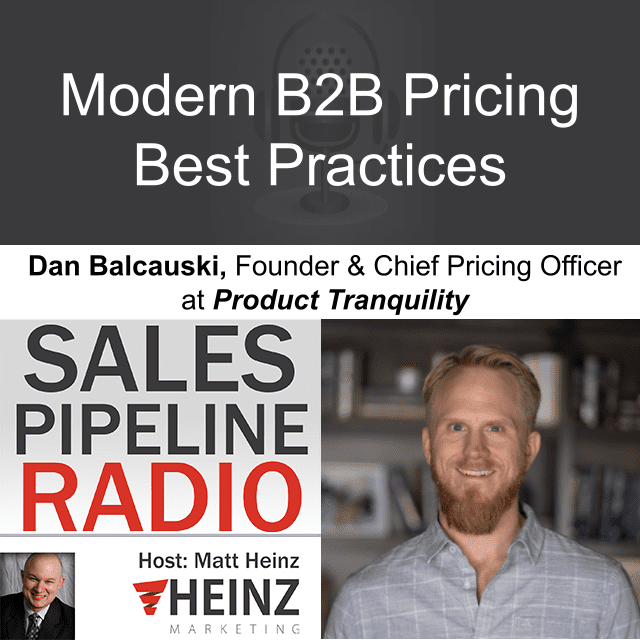Sales Pipeline Radio, Episode 344: Q & A with Jennifer Ross

Summary
Matt interviews the best and brightest minds in sales and Marketing on Sales Pipeline Radio. This week he talks with Jennifer Ross, CMO at Intentsify about using Intent signals to optimize content and sales outreach.
By Matt Heinz, President of Heinz Marketing
If you’re not already subscribed to Sales Pipeline Radio or listening live Thursdays at 11:30 am PT on LinkedIn (also on demand) you can find the transcription and recording here on the blog every Monday morning. The show is less than 30 minutes, fast-paced and full of actionable advice, best practices and more for B2B sales and marketing professionals.
We cover a wide range of topics, with a focus on sales development and inside sales priorities. You can subscribe right at Sales Pipeline Radio and/or listen to full recordings of past shows everywhere you listen to podcasts! Spotify, iTunes, Blubrry, Google Play, iHeartRADIO, Stitcher and now on Amazon music. You can even ask Siri, Alexa and Google or search on Audible!
This week’s show is entitled, “Using Intent Signals to Optimize Content & Sales Outreach”. My guest is Jennifer Ross, CMO at Intentsify.
Tune in to:
- Discover how intent signals go beyond mere buying indicators
- Dive into the intricacies of intent data and why treating all signals as buying signals can be counterproductive.
- Learn how to effectively activate intent data across your organization, from marketing and sales to customer success, and why it’s becoming the new currency in marketing.
Watch the video, listen in below and/or read the transcript below.
Matt: All right. Welcome everybody to another episode of Sales Pipeline Radio. I’m your host, Matt Heinz. Excited to be here with you as we finish up August and start a new month. Labor Day is right around the corner as we record. This also means college football is back, which I’m very excited about. We’re getting back into intent event season. Jennifer, we got SaaStr, we got Salesforce, we got InBound, we got Pavilion, we got a bunch of great events coming up, but excited to have y’all here. If you are listening to or watching this episode live, we’re really excited that you’re here.
Thank you very much for subscribing for downloading. We are somewhere around episode 365 of Sales Pipe Radio over the years, and you can find every episode past, present, and future up@salespipelineradio.com. Today I want to talk about intent signals and a broader definition of what I think intent signals mean and how they can be used; and couldn’t think of anyone better than to bring on Jennifer Ross. She is the CMO of Intensify. If you know that name and you’re in B2B, you may have recognized her for many years at SiriusDecisions and Forester, and excited to have you here. Thanks for joining us.
Jennifer: I’m so happy to be here. Matt, thanks for having me. This is a great topic, and of course, near and dear to my heart.
Matt: I think everyone’s looking for buying signals, and I think when we think about intent signals, sometimes we think about intent to buy and think of those things. To me a little too closely related, how do you define an intent signal and what should that mean for B2B buyers and sellers?
Jennifer: That’s a great question, Matt, and it’s something that we even talk about internally at Intensify. At its most basic level, intent data is information collected about a web user’s content consumption activities in their research behaviors. So it can directionally point to, or correlate to what you might say would be buying behaviors, but you are really looking at their footprint, if you will. So with this info, B2B teams go to market teams. They can gain a ton of understanding and create greater efficiencies with their go-to market motions by looking at which companies may seem most likely to buy based on their behavior, so they can effectively allocate resources to the right accounts. The thing that they can also see is what is it seeming that these companies, these accounts care most about? Because if we know that, we can select the right messages and content to engage them further in their efforts.
And then the last thing I would say is the how, right? So there’s who’s looking the, what are they looking at and the where do we think based on those research and content consumption behaviors might point to where they could be in a buying journey. So you can deliver the right messages the right way at the right time. And although those are generally easily understood, you asked the right question because intent data can also get complicated quickly. Lots of different types, lots of different derivation methods, scoring models and so on and so forth. So we’re in line with the way that you are thinking about it. They’re correlated in parallel, but they’re not one in the same thing.
Matt: If you take all those different signals and you treat them all as buying signals, the majority of the time you may be pushing a prospect faster than they’re ready to go. They may ultimately have an acute need you can solve, but the signal you’re looking for may be something around education that they’re doing. It may be around the fact that a problem is becoming prescient enough where you’ve seen this movie before, you know where it’s going, but the prospect isn’t there yet. I know we’re all in a hurry to sell. We’re all in a hurry for our BDRs to set appointments. But talk a little bit about discipline and patience and the importance of some of those early and mid journey signals and how to best leverage those.
Jennifer: I’ll start off first kind of going back to when you’re using intent and you’re moving too quickly the way that you described Matt, you also could be getting false positives when you’re looking at keywords and topics. So one of the things, shameless plug, but it fits into this what we’re talking about, one of the things that Intentsify does differently is we actually introduce beyond the keywords and business topics, a next generation intent derivation method that says that’s actually not enough. We are going to look at your content, your webpages, the things that you say your organization does, what problems do you solve, how does your solution solve it, and factor that in as well so that you’re actually getting a closer match to not just that broad keyword or topic, but you’re getting a closer match to people who are generally interested in solutions that you can provide.
And we also think about, again, the different stages right now, even internally, we can imagine a big thing for us is drink our own champagne. Anybody that’s in B2B tech selling to other B2B marketers or salespeople, we’ve got to demonstrate that we’re doing this internally. And so we’ve recently implemented Forester’s latest revenue waterfall that looks at opportunities, buying groups, multiple opportunities on an account, but how intent can also inform how they move from stage to stage, which gets at where you were headed too– you don’t treat them just like the old days when you looked at an individual and an MQL coming in the top, you wouldn’t treat them the same way all the way through. So now you’ve just got better data and more insights with intent to really think about the next best action based on where they are and helping to offer up things that are going to help them move to the next stage.
Matt: I think what’s sometimes an unpopular opinion in companies that have a bit of a impatience is that three steps are faster than one where we see something and we want to fast forward the story, we want to move them more quickly to where we think we believe they need to go. Your prospect may not be at that speed, and if you push them too fast, that creates artificial friction. I think also talk about the fact that an intent signal doesn’t mean the same to every individual in the organization. When we think about the buying committee, people with different roles, different perspectives, different needs, a company intent signal may need to be translated and communicated in a different way to different people to help them each reach consensus on a commitment to change. Talk a little bit about how to do that.
Jennifer: Good point, and probably we should talk a little bit about (because we may have different audiences listening in today), different types of intent data. We know most people are using some form of intent, but it’s probably good to just level set on when we think about intent data. We’ve got party type and source type. So we’ve got third party data, which is the broadest set available and the best source for early interest signals. You’ve got second party data, which is great for late stage signals and use cases. Coverage is a bit more limited. And then you’ve got first party data, great for early and late, but also limited coverage. And it’s important to note that each source type comes with its own strengths and weaknesses. They’re all very complimentary. It’s best to use at least one source from one party type to get the coverage, breadth and insight depth that you need. So a basic understanding of what we even mean by intent data and all the different types of intent data that can come into play are important for you when you’re thinking about how you’re going to utilize it and leverage it in your own situation.
Matt: That’s right. Talking today on Sales Pipeline Radio with Jennifer Ross, CMO of Intentsify and really liked this comment from Dennis here talking about, how you can have this information, but how you divulge that to a client or a prospect needs some nuance. You may see that someone was on your buying page and you don’t want to call them or email this afternoon and say, I saw you are on our buying page. How do you teach an organization to create, to do the art in the science there, to take the data, to implement the data, but to be careful and thoughtful about how that is communicated implemented?
Jennifer: That’s a great point, and I would say that isn’t specific to just intent data. The way that we’re talking about it today in general, we all have to be careful. There’s that line that you can easily cross that. I get emails like that every day of, Ooh, that’s creepy, or BDR is now doing text messages. I mean, things are changing and they’re trying all different kinds of channels and tactics. So the way that intent can help play a role there is if we go back to talking about when you’re looking at intent and you’re looking at potentially multiple sources and what content has been consumed, and you’re drawing that correlation to where we think they are in their buying, buying decision making process and what we know about them at intensify, we bucket those into tiers. So again, we’re not saying it is where they’re, and they’re buying journey.
We’re saying, this is the research stage we believe they’re at, which you can correlate potentially to, oh, a lot of this is they’re doing education, they’re doing this. So if you have that kind of tiering and level based on research stages that you can correlate to where they’re in their buying journey, you can be more thoughtful and planful about the next action, the next piece of content you’re going to send, what you’re going to say in that outreach message from your BDR team. So that’s the way we have our team internally working is looking holistically. They have a dashboard they go into every day before they do any action. They’re factoring in the intent score, aggregate level, but they’re looking more granularly at the actual assets and that tiering model.
Matt: These are the questions that I think you’re kind of addressing here, Jennifer, the right journey to each prospect and stack ranking some of the data that is used in that journey. I want to talk a little bit about activating. This is a marketing job. Is sales involved in doing this? Is this sort of a sales enablement function? How do you start to activate, even if you decide, okay, here’s the message to these type of workflows and people in the buying journey, how is this activated and deployed across an operational team?
Jennifer: Love that question. And for those marketers that are familiar with and are using or know the concept of the demand waterfall, that’s a bit where I started in thinking about all the different ways that we could leverage intent across the organization before you’re even, anything comes into the waterfall intent can be used to help identify your target account list, prioritize your target account list, expand your ICP, right? We may think we know who our target account list, who should be on it, are there lookalikes? Are there companies that we’re missing that are interested in the same things? It can be activated via digital programs. So for example, you’ve got intent providers like Intentsify. There’s different kinds of intent providers. You’ve got data providers that are focused on selling the data alone. You’ve got ABM platforms that usually license that as part of a broader platform.
You’ve got campaign execution where they focus on activating that intent through things like content syndication, display advertising, and then you’ve got some what Forrester calls walled gardens. So mainly in the realm of second party data sources with pricing based on access to a private community. But so you can drive top of funnel, you can do intent fuel display advertising that can be used for creating awareness that feeds into intent fueled content syndication. You can use the display advertising in the backend of something like content syndication for nurture. We use it as I touched on earlier of, okay, now we’ve got some engagement and some interest that was informed by our intent. In fact, we decided where to spend marketing dollars based on the accounts that we’re showing in market, used those types of engagement activities. And then now we’ve got them flowing into a BDR team that again uses that intelligence and those intent scores to prioritize who they’re going to follow up with, how they’re going to follow up, what we would offer as the next step. So we’re using it for all of those things.
I’ll say one more thing that wasn’t in the question, but how do you activate it? So those are some tactics for activating it, but the beauty of the intent data and the intelligence you can get from that is we all know, we’ve always said success depends on marketing, sales alignment. Well, now that’s even a greater challenge in organizations. It’s marketing, it’s sales, it’s customer success, it’s the product team, and the intent intelligence really can become the backbone or the foundation for driving that kind of alignment because we’re all looking at the same dashboard and at the same information of what’s going on in that account and taking action in unison together in a unified way.
Matt: It seems to me that, just in this conversation that data and intelligence is almost replacing media as the coin of the realm and a differentiator for marketers where it’s not just all about reaching people on search in digital channels in a one to many way, but the intelligence that is around us that is available to us today allows us to have a one-on-one conversation almost infinitely at scale. And so an investment in those tools, in that technology allows for better, more precise conversations. Doesn’t eliminate media from your mix, but how should marketers be thinking about, I mean, look, it’s already September, we’re thinking about 2024 already. How should marketers be thinking about budget mix in this age of vastly greater information available?
Jennifer: Yeah, you’re spot on where we are coming up right into that season, and we all say we can’t do that without data. So anytime we get into conversations about what’s the best strategy?, what are the best channels?, what are the best tactics?, that can vary greatly depending on the organization, depending on the audience you’re going after. But one thing that doesn’t vary is to do it efficiently and effectively. You need the right information. You need to understand what your audiences need or where they’re going for that information. And sometimes when you are thinking about also budgeting for something like, well, we need to invest in intent data, it tends to be pigeonholed into one bucket. Like, oh, okay, I’ve got to increase my demand bucket. We’re going to do content syndication. But if you think about it holistically, it’s full funnel.
So think about things like cross-selling and upselling intent data can reveal a customer’s intent to explore additional products and features, and that information empowers sales reps to present relevant cross-selling and upselling opportunities. Competitor insights, do we know if they’re suddenly looking? Could be our existing customers, do we know if they’re suddenly searching our competitors? What we know from having done our own research is everyone knows that intent data seems that the vast majority of sales and marketers know intent data is table stakes. But what we see is, they’re not leveraging it across all of these use cases. So they may, from a how do I build the business case for my budget? They may not have the strongest story for that because they’re missing opportunities to use it across all of these different use cases.
Matt: I’m really, really glad you brought that up. If you’re not thinking about intent signal usage across your customer base, you’re missing an opportunity to find buying signals for additional products and services. You’re missing warning signs, as you just mentioned of them, surging looking at a competitor’s site. They may just be getting educational materials that may be a sign that they’re not satisfied. So every intent, and if you think about, we’ve been thinking more recently about customer led growth quite a bit. We’ve got Julie Persofsky from Winning By Design, who’s done a ton of great work in this space coming up in a couple of episodes, and just this idea of thinking about that user committee, that customer committee as at least the same complexity, if not more complexity than the buying committee and thinking about stages and needs and signals. Huge, huge opportunity. So Jennifer, for people that are sort of nodding their heads, this sounds great, where else can people look? Where can they learn? I know there’s a lot of great information on intentsify.com, but where else can people learn and get started on this journey?
Jennifer: Oh, so many great places. I mean, always coming from the likes of a SiriusDecisions and then Forrester, I would say anytime you’re looking at something that’s a new or emerging category, they’ve got great information about the different types of intent providers, how they differ. Again, I would say go to community sites for, there’s lots of great blogs out there about different types of understanding, the different types of intent, why you might want to consider more than one source of intent. And there’s a plethora of places that you can go. But I always start with some great blogs from marketing communities, like a MarketingProfs. Almost anywhere you go, you’ll find information on different use cases. Just today, we’re all searching everything AU, generative AI, AI. Well, what we are doing at a company like Intentsify, it’s AI fueled, I mean that ability to identify the research that’s being consumed, to map it to your company’s offerings. It’s AI, it’s natural language processing. It’s the latest in AI technologies, and there’s tons out there on those topics as well.
Matt: Absolutely. Well definitely encourage folks to go to intentsify.io. Look at the media library. There’s some really good educational content up there. Just if you’re getting up to speed, Forrester’s done some reports on data providers that are worth looking at. And to Jennifer’s point, some great communities Pavilion, RevGenius, really great. Just like go to RevGenius, sign up for their stuff and just do a search for intent signals or signals, and you’re going to find practitioners that are deep into this already you can learn from. Well, Jennifer, thanks so much for joining us for this episode. This was a lot of fun. It always goes fast, but it’s good to see you again. Great to see you on the road a little more often these days. And thanks again so much for joining us.
Jennifer: Great to see you too. Look forward to passing each other in the hall at the next event.
Matt: And thanks everyone for watching and listening. This is another episode of Sales Pipe. I’m Radio. We’ll see you next week. Take care.
Listen to the Latest Episodes:
Matt interviews the best and brightest minds in sales and Marketing. If you would like to be a guest on Sales Pipeline Radio send an email to Sheena@heinzmarketing.com.



